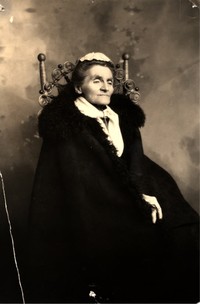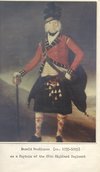
Source: Link
COX, CHARLOTTE SELINA (Bompas), Church of England missionary; b. 24 Feb. 1830, likely in England, daughter of Charlotte Skey and Joseph Cox, md; m. 7 May 1874 William Carpenter Bompas* in London, England; they had no children; d. 21 Jan. 1917 in Montreal.
Selina Cox, who was known as Nina, led a pleasant and comfortable middle-class childhood in England with her brother and two sisters. When she was a young woman, the family moved to Italy for her father’s health; it was an experience that she would recall with great fondness later in life.
Nina initially showed little interest in religion. Her brother, Joseph Mason Cox, was a vicar, but she later recalled that she thought his missionary meetings were “the dullest affairs” at which the speakers were “the most dismal old slow coaches it was anyone’s unhappy fate to attend to.” In 1871, however, the murder of a prominent missionary bishop in Melanesia sparked an evangelical awakening. Nina now felt called for mission work, and an opportunity presented itself when her cousin William Bompas, a missionary for the Church Missionary Society in the Canadian northwest and recently consecrated bishop of Athabasca, proposed marriage to her in 1874. Just five days after the wedding the couple commenced the lengthy journey to Bompas’s headquarters at Fort Simpson (N.W.T.), a Hudson’s Bay Company post on the Mackenzie River.
The new circumstances in which Nina found herself were far removed from her romantic images of missions in China and Japan. For a woman in her mid forties, the change must have been something of a shock. Her home was little more than a log shack and there were times when the HBC post faced near-starvation. Her husband was frequently away visiting potential converts in their camps, leaving Nina to fend for herself. “I feel so lonely and desolate at times,” she confided in the diary that she began for her sisters in England.
However, the woman described later by her niece as “self-willed, impulsive” but also “full of kind thoughts for others” was not one to sit and feel sorry for herself. She threw her considerable energies into the work of the mission, learning the Slavey language and taking a particular interest in native women. She also played the harmonium, bringing music to the Spartan church services which was much appreciated by the native members of the congregation, who enjoyed music tremendously. In her husband’s absence in the summer of 1876, she travelled to Fort Chipewyan (Alta) to make preliminary arrangements for the establishment of a new mission.
Perhaps most important to her was her work with children. She offered religious and reading instruction, organized several children’s choirs, and became known for her kindness in taking care of children whose parents were ill or absent. She informally adopted two of these children, planning to raise them as her own. The first, Jenny (Jeannie), died as an infant and the second, Owindia (baptized Lucy May), apparently died in England as a toddler. Nina also undertook medical work in the diocese. She was a firm believer in homoeopathic remedies and always carried the appropriate supplies.
The difficult living conditions soon took their toll. Nina suffered regularly from severe headaches, and during the winter of 1876 was struck with some more serious illness. In the spring, she travelled out to Winnipeg to recuperate. After two years she went back to mission work at Fort Simpson, but in 1883 she was summoned to England.
While in England, Nina spoke to a number of audiences about the CMS’s North-West America mission and arranged the publication of her little book Owindia, in part a romantic tribute to Lucy May and in part publicity for the mission work. She returned briefly to the Mackenzie mission in 1886–87, but health and family concerns drew her back to England again and then to Montreal, where she remained until 1892. Here she worked actively with various women’s auxiliaries to promote an interest in northern mission work. Fund-raising was crucial because her husband had little interest in practical money problems and the CMS was gradually withdrawing its support. While she was in Montreal, the new diocese of Selkirk (now Yukon) was created and Bishop Bompas moved to Buxton mission at Forty Mile, on the Yukon River. Nina joined him there in 1892.
In 1896 she was summoned to England again because her elder sister was seriously ill; when she returned to the Yukon, she found herself in the middle of the Klondike gold-rush. She embraced the miners at the mission just as warmly as she had the native peoples, opening a social centre to provide magazines, newspapers, music, and a little religion to improve their lives. In 1901 Bishop Bompas moved his permanent headquarters to Caribou Crossing (Carcross), and three years later Nina went on a tour to speak to women’s auxiliaries in Toronto, Ottawa, Montreal, and Quebec. She raised $800 in Toronto so that a church could be built at Carcross.
Then on 9 June 1906 her beloved husband died and she decided to move to Montreal to live with two nieces in Westmount. Until her death in 1917, in spite of her frail body, she continued to speak about northern mission work and inspired her friends and audiences with the example of her life and her enthusiasm for Christian proselytizing.
While Selina Cox Bompas is often remembered as the wife of a well-known missionary, it is clear that she saw herself as a missionary in her own right. Indeed, her contributions to the CMS mission in terms of teaching and fund-raising may, in the end, have had a more lasting effect on northern society than his evangelizing.
Charlotte Selina Cox Bompas is the author of Owindia: a true tale of the Mackenzie River Indians, North-West America (London, [1886?]). Her memoirs were published as A heroine of the north; memoirs of Charlotte Selina Bompas (1830–1917), wife of the first bishop of Selkirk (Yukon), with extracts front her journals and letters, comp. S. A. Archer (London, [1929]).
NA, MG 17, B2, G, C.1/O (mfm.). PAA, ACC, Diocese of Athabaska records, A.281/21–27. PAM, HBCA, Z.13/1. K. M. Abel, “Bishop Bompas and the Canadian church,” in The Anglican Church and the world of western Canada, 1820–1970, ed. Barry Ferguson (Regina, 1991), 113–25; “The drum and the cross: an ethnohistorical study of mission work among the Dene, 1858–1902”
© 1998–2024 University of Toronto/Université Laval
Image Gallery


Cite This Article
Kerry M. Abel, “COX, CHARLOTTE SELINA (Bompas),” in Dictionary of Canadian Biography, vol. 14, University of Toronto/Université Laval, 2003–, accessed April 28, 2024, http://www.biographi.ca/en/bio/cox_charlotte_selina_14E.html.
The citation above shows the format for footnotes and endnotes according to the Chicago manual of style (16th edition). Information to be used in other citation formats:
| Permalink: | http://www.biographi.ca/en/bio/cox_charlotte_selina_14E.html |
| Author of Article: | Kerry M. Abel |
| Title of Article: | COX, CHARLOTTE SELINA (Bompas) |
| Publication Name: | Dictionary of Canadian Biography, vol. 14 |
| Publisher: | University of Toronto/Université Laval |
| Year of publication: | 1998 |
| Year of revision: | 1998 |
| Access Date: | April 28, 2024 |






